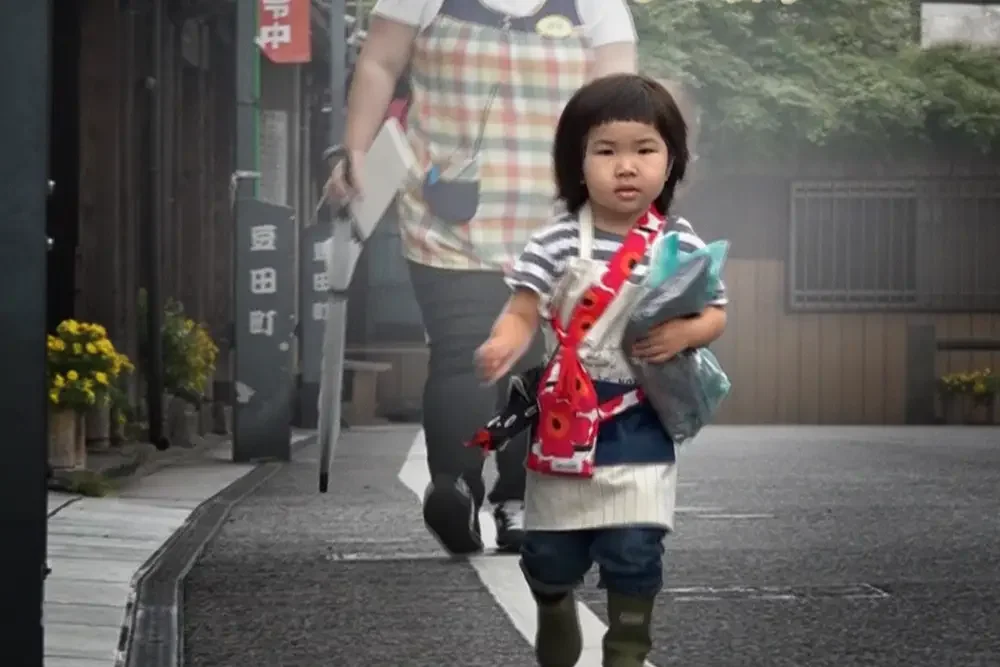The premise of Old Enough!, a Japanese reality show newly streaming on Netflix, is childishly simple. In each 10-minute episode, a tiny kid sets off to complete the child’s first errand alone. (Well, “alone,” with the cameramen.) The children totter off into the neighborhood, forget what they’re supposed to be doing, burst into tears, and ultimately make their way back to Mom and Dad laden with plastic shopping bags, having succeeded in their mission. Hajimete no otsukai, which is based on a children’s book of the same name from 1977, has run on Japanese TV for more than 30 years—long enough that some kids on the show’s newer episodes have parents who were on the show!
In the first of the 20 episodes made available to Netflix subscribers, a 2-year-old travels to the town convenience store to buy groceries for Mom. In the fourth, 3-year-old Yuka crosses a five-lane road in Akashi, a city the size of Cincinnati, to get to the fish market. “Can you go all the way to Uonotana without getting hit by any cars?” Mom asks.
Needless to say, if the show were set in the United States, the parents would be under investigation by child protective services, and the children in foster care. Like many things about Japan, it would be easy to attribute Hajimete no otsukai (literally, “First Errand”) to some cliché about Japanese essentialism. But the Japanese are not so different from us. They’ve just made policy choices that make it possible for kids to run their first errand a decade before their American counterparts get to do the same.
“In Japan, many kids go to neighborhood schools on foot and by themselves, that’s quite typical,” said Hironori Kato, a professor of transportation planning at the University of Tokyo. Typically, Japanese children don’t actually run errands for Mom and Dad in the city at 2 or 3 years old, he notes, as they do in the show. But the comic, TV-friendly premise exaggerates a truth about Japanese society: Children in Japan have an unusual degree of independence from an early age.
“Roads and street networks are designed for kids to walk in a safe manner,” Kato said. Among the factors, he said: Drivers in Japan are taught to yield to pedestrians. Speed limits are low. Neighborhoods have small blocks with lots of intersections. That means kids have to cross the street a lot—but also keeps drivers going slow, out of self-interest if nothing else.
The streets themselves are also different. Many small streets do not have raised sidewalks but depend on pedestrians, cyclists, and drivers to share the road. Curbside parking is rare, which creates better visibility for drivers and pedestrians and helps give the smaller streets of big Japanese cities their distinctive feel. In fact, I first heard about Hajimete no otsukai from Rebecca Clements, a research fellow at the University of Sydney who has written a dissertation on Japan’s approach to parking: Car-buyers must show proof of an off-street parking space to make their purchase. For Clements, the show is evidence of how Japan gives children a “right to the city.”
Japanese kids make a lot of weekday trips on foot—especially those between 7 and 12 years old, who walk for almost four in five trips. Neighborhood schools are the driving force behind a lot of this travel, with many schools employing “walking school buses”—a morning parade of kids in which the older ones help guide the younger ones. But the school trips also introduce children to their neighborhood, which can facilitate other kinds of travel.
“I went into it saying, ‘Is it the built environment or the culture?’ ” recalled E. Owen Waygood, a professor at Montréal Polytechnique who wrote his Ph.D. thesis at Kyoto University on Japanese children’s travel and land use. “There is an underlying cultural value—Japanese parents believe kids should be able to get around by themselves. And they build policies to support that. Japanese cities are built on the concept that every neighborhood should function as a village. That planning paradigm means you have shops and small businesses in residential neighborhoods, which means there are places to go—places these kids can walk to.”
Waygood’s research revealed that kids in Japan were more likely to travel independently in mixed-use, urbanized neighborhoods. That was in part because destinations were close at hand—but also, upending a common stereotype about cities as alienating and anonymous environments, because children in cities were more likely to see people they knew on such trips.
It’s not as if Japanese parents don’t also fear stranger danger; while crime is low by Western standards, kidnappings are not unheard of. One such incident is at the heart of Six Four, the 2012 detective novel by Hideo Yokoyama, which was a smash hit in Japan and abroad.
But instead of telling children to keep to themselves, Waygood observed, kids are taught to say hello to the people they pass—part of the Japanese greeting culture, aisatsu. Along with neighborhood events like block parties and festivals, that helps build up a dense social network that can help out in a pinch, like in Hajimete Episode 7, when the local hardware store owner helps Miro cross the street. In a survey of 14 countries, Japanese parents were the most likely to agree with the idea that neighborhood adults look out for other people’s children.
The biggest winner of this system might be Mom. When kids need a chaperone, the role falls mainly to Mom, in both the U.S. and Japan. But Japanese kids ages 10 and 11, Waygood found, make just 15 percent of weekday trips with a parent, compared with 65 percent of trips for American kids. A city that frees children also frees their parents.
That’s a cultural difference. But it’s one that is deeply associated with a different approach to designing cities and neighborhoods—one that we could easily copy, if we wanted to.
